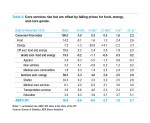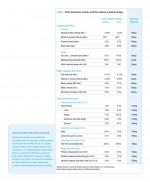Inflation
Scorecard
In 2015, our Inflationary Pressures Scorecard started the year tilted toward a benign price outlook. Pressures picked up in the third quarter only to retreat to a more even balance in the next quarter.
Looking at our current scorecard, price pressures have receded, with increases evident in six indicators, declines in 14, and three showing stable pressure – nearly the same results as January 2015. Combined with our Consumer Price Index analysis, a few key themes emerge. A strengthening dollar has helped keep food, energy, and core goods prices very weak. Price increases have been confined to core services, where, with the exception of housing services, rising labor costs represent a potential threat.
We expect the overall price environment to remain benign as the year begins, but careful attention should be given to labor costs. Additionally, the benefits from a strong dollar and falling commodity prices are likely to fade, if not reverse, at some future point. Even with these medium-term concerns, the likelihood of runaway inflation remains exceedingly low.
Consumer Price Index Analysis
Key trends in the Consumer Price Index, or CPI, remain on track. Weakening food, energy, and core goods prices are offsetting rising core services prices.
Over the past 18 months, the strengthening dollar has helped restrain goods prices. For goods produced domestically, falling commodity prices reduce input costs, resulting in lower prices for finished consumer products. A strong dollar also cuts the cost of imports. These benefits come on top of a longer-term trend of increasing imports of goods from countries with lower production costs.
The main sources of price increases in the CPI are core services: housing, medical care, transportation, and education, and all are rising faster than goods prices. Each one has unique circumstances that may continue the trend.
The price of housing services consists of rent, both that paid by renters and owners’ equivalent rent, which is analogous to what owners would pay to rent their own property. Since the housing boom and bust, there has been a significant shift toward renting, driving up rents at an above-average pace.
Medical care has been another persistent source of CPI gains. Medical care is more heavily regulated than most industries. It is susceptible to litigation costs, tends to have high costs for new product development, and is in the midst of a demand surge from aging baby boomers.
Finally, education has for years posted sustained, large price increases, and higher-education costs have been a significant contributor to overall CPI gains.
We expect prices in aggregate to continue to reflect offsetting trends in the short term (dollar strength) and longer term (demographics, increased imports from low-cost countries). But we see little chance of runaway inflation stemming from inappropriate monetary policy.
Click here to receive email notifications when the latest Business Conditions Monthly is available.
Everyday Price Index
AIER’s Everyday Price Index, or EPI, slid 0.6 percent in November, matching October’s decline.
Over the past 12 months, the EPI has fallen 2.3 percent while the broader CPI has risen 0.5 percent. The CPI fell 0.2 percent in November. Because the EPI assigns a greater weight to energy, the difference between the two stems largely from falling energy prices.
Elevated crude-oil inventories and weak prices drove the decline in energy. Crude inventories climbed 19.8 percent over the past 12 months, helping to drive prices down 38.7 percent over the same period. Hefty inventories and depressed crude prices add up to lower consumer costs at the pump. Gasoline prices have dropped 24 percent over the past year.
Food prices at grocery stores have risen just 0.3 percent over the past 12 months, well below the historical average. The slow pace likely reflects reduced demand. As consumers prepare fewer meals at home, they purchase more at restaurants. That has meant strong demand and a 2.7 percent gain in food prices at restaurants over the past year.
Next/Previous Section:
1.Overview
3. Inflation
6. Pulling It All Together/Appendix



